The C# Major chord, often written as C# or Db (D-flat), is a foundational chord for guitarists. It’s a versatile chord that appears across numerous musical styles and is essential to add to your chord vocabulary. This guide will take you through everything you need to know to play the C# Guitar Chord effectively, from basic shapes to more advanced techniques.
Delving into C# Major Chord Theory
Before we jump into shapes, let’s understand what makes up a C# Major chord. Understanding the theory will deepen your musical knowledge and make learning chords easier in the long run.
- Notes: The C# Major chord is composed of three notes: C#, E#, and G#.
- Scale Degrees: These notes correspond to the 1st (root), 3rd, and 5th degrees of the C# Major scale.
- Intervals: Like all major chords, the C# Major chord contains specific intervals from its root: a Major 3rd, a minor 3rd, and a Perfect 5th (octave).
- Key of C# Major: The C# Major chord is the tonic (or I) chord in the key of C# Major. The complete set of chords in this key are: C#, D#m, E#m, F#, G#, A#m, and B# diminished.
Knowing this basic theory provides a solid foundation for understanding how the C# chord functions musically.
10 Essential Shapes for Playing the C# Chord
To get you started, here are 10 different shapes for playing the C# Major chord on the guitar. Experiment with these to find which voicings you prefer and which work best in different musical contexts.
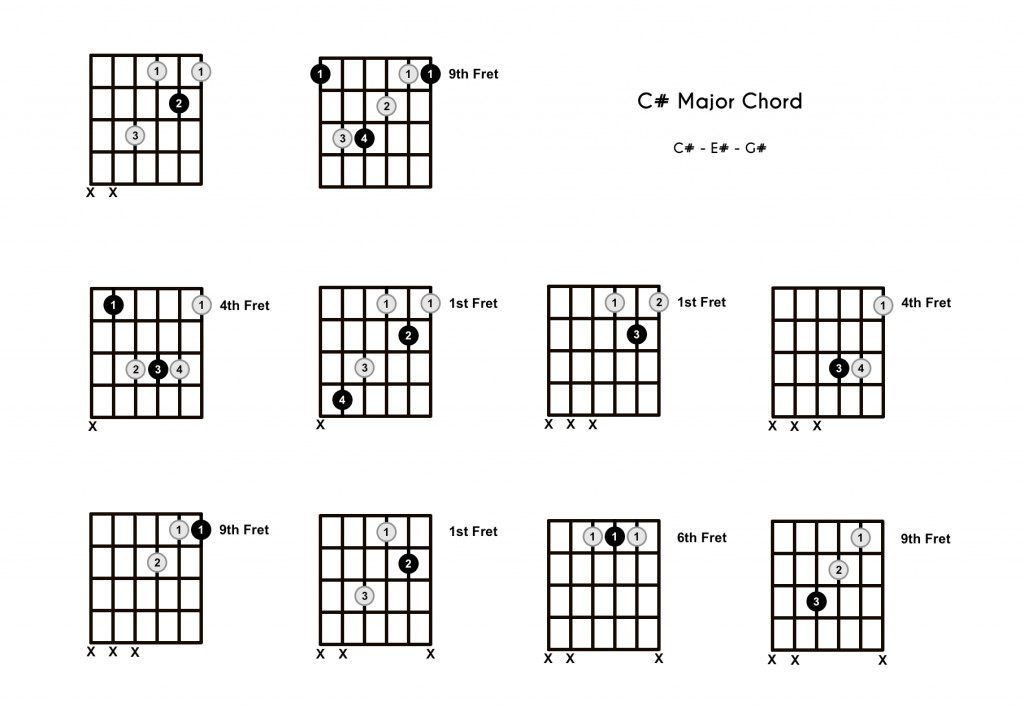 C Sharp Major Chord 10 Shapes
C Sharp Major Chord 10 Shapes
The Standard C# Chord Shape: Root on the 5th String
The most common way to play the C# chord is as a barre chord, using the root-5 barre chord shape. This shape is typically positioned at the 4th fret. Often, guitarists will play this shape where the index finger presses down only on the root note on the 5th string, rather than barring across all strings.
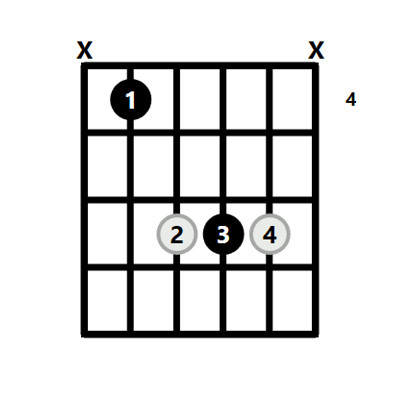 Standard C Sharp Chord Guitar Shape
Standard C Sharp Chord Guitar Shape
The “Easy” C# Chord Shape: A Simplified Version
If barre chords are still challenging, try this simplified version of the C# chord. It utilizes only the top three strings and is an excellent starting point for beginners. This shape is identical to a D Major chord shape, but moved down one fret (remember, C# is enharmonically equivalent to Db). This is a fantastic way to introduce the sound of the C# chord into your playing without complex fingerings.
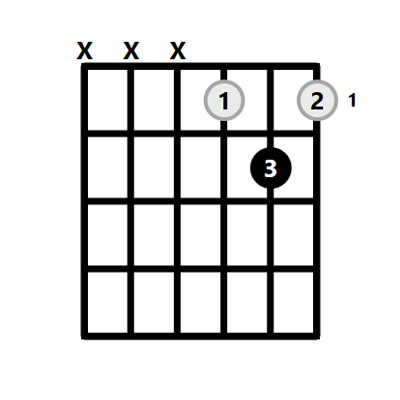 Easy C Sharp Chord Guitar Shape
Easy C Sharp Chord Guitar Shape
Step-by-Step Guide to Playing the Standard C# Chord
Let’s break down the standard C# chord shape into a step-by-step instruction to ensure you’re playing it correctly:
- Index Finger: Place your 1st finger on the 4th fret of the 5th string (A string).
- Middle Finger: Place your 2nd finger on the 6th fret of the 4th string (D string).
- Ring Finger: Place your 3rd finger on the 6th fret of the 3rd string (G string).
- Pinky Finger: Place your 4th finger on the 6th fret of the 2nd string (B string).
- Strumming: Avoid strumming the 6th string (low E string) and strum down from the 5th string to the 1st string.
Following these steps carefully can be particularly helpful if you’re unsure if you are forming the chord correctly. It’s a great way to double-check your finger placement and ensure a clean sound.
Barre Chord Forms for C# Major
As mentioned, the C# chord is frequently played as a barre chord. You can use two main barre chord shapes to play C#:
- Root 6 Barre Chord Shape: Based on the E Major shape, barre at the 9th fret.
- Root 5 Barre Chord Shape: Based on the A Major shape (standard C# shape described above), barre at the 4th fret.
Barre chords are essential for playing chords all over the guitar neck, providing flexibility and access to different voicings.
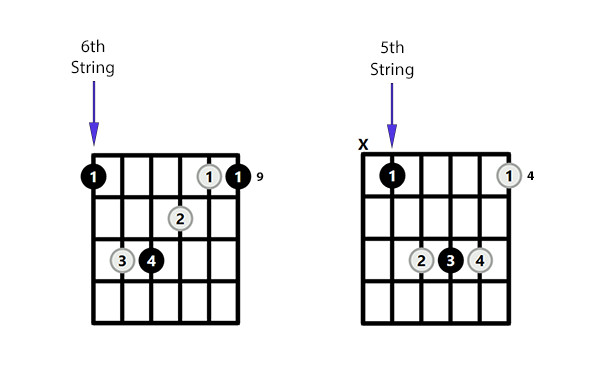 C Sharp Barre Chord Guitar Shapes
C Sharp Barre Chord Guitar Shapes
Exploring C# Major Triads
Beyond full chord shapes, understanding and utilizing triads is a valuable skill for any guitarist. Triads are three-note chords that offer a more stripped-down and often clearer sound. Here are the three inversions of the C# Major triad:
- Root Position: C#, E#, G#
- 1st Inversion: E#, G#, C#
- 2nd Inversion: G#, C#, E#
These triads can be played in various positions on the fretboard, giving you different sonic colors and voicings for the C# Major chord.
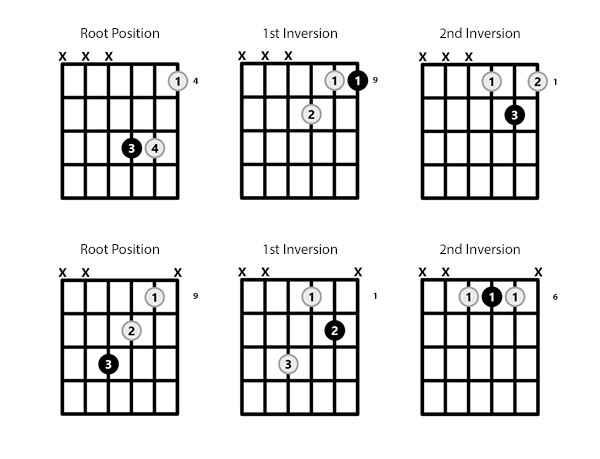 C Sharp Major Triad Guitar Shapes
C Sharp Major Triad Guitar Shapes
Musical Keys Featuring the C# Chord
Knowing which keys contain the C# chord will help you understand its musical context and how to use it in songs and progressions. The C# Major chord naturally appears in these keys:
- C# Major: (I chord) C#, D#m, E#m, F#, G#, A#m, B#dim
- G# Major: (IV chord) G#, A#m, B#m, C#, D#, E#m, Fxdim
- F# Major: (V chord) F#, G#m, A#m, B, C#, D#m, E#dim
- A# minor: (III chord) A#m, B#dim, C#, D#m, E#m, F#, G#
- D# minor: (VI chord) D#m, E#dim, F#, G#m, A#m, B, C#
Alternative C# Chord Shapes for Variety
While the standard shapes are crucial, exploring alternative voicings can add depth and interest to your playing. These shapes might not be as common but offer unique sonic textures and can be useful in specific musical situations. Experiment with different inversions and partial chord shapes to expand your C# chord vocabulary.
Chord Substitutions for C# Major
In certain musical contexts, you can substitute the C# Major chord with related chords to create harmonic variations. Consider these substitutions:
- C#sus4: Adds a suspended 4th, creating a slightly unresolved and richer sound.
- C#sus2: Adds a suspended 2nd, offering a brighter and more open sound.
- C#add9: Adds a 9th interval, creating a jazzy and extended harmony.
Conversely, the C# Major chord can often act as a substitute for more complex chords like C# Major 7, C#7, and other extended chords with C# as the root, although it’s not a substitute for minor chords.
Scales to Play Over the C# Chord
When improvising or writing melodies over a C# Major chord, certain scales will work particularly well. These scales are harmonically compatible and will create melodic lines that complement the chord’s sound:
- C# Major Scale: The most natural choice, outlining the chord tones perfectly.
- C# Pentatonic Major Scale: A simpler, 5-note scale ideal for blues and rock improvisation.
- C# Lydian Mode: A major scale with a raised 4th, offering a brighter and more ethereal sound.
Expand Your Chord Knowledge
[

